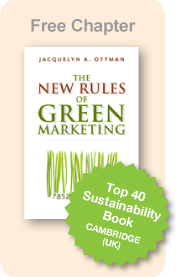Jacquie Ottman's
Green Marketing Blog
A Better Approach to Tackling Greenwashing Than Pointing Fingers
November 14, 2010 by Jacquelyn Ottman
I have been doing a lot of finger-pointing of late in response to Terrachoice’s latest 2010 Sins of Greenwashing “Home and Family Edition”. Two wrongs don’t make a right. So, let me clarify my position—and in keeping with my normal positive self, offer some concrete suggestions for moving the industry forward.
Rather than analyzing green marketing claims as they appear on the shelf and concluding there’s either something ill-intended about the marketers’ making them (however, clumsily tongue in cheek), or that greenwashing is nearly impossible to avoid, let’s start by facing the fact that determining what exactly can be claimed as “green” is damned challenging, if not outright impossible—and then figure out what we can do about it to move the market in a greener direction.
As I point out in my soon to be released book, The New Rules of Green Marketing, there’s no such thing as a green product—all products use resources and create waste. So, as green marketers, we are left with positioning our products as “greener” — greener than a competitor’s entry, greener than our product was last year, or even greener for a particular climate, geography, or use, perhaps, —but green-“er” nevertheless. So claims, ecolabels, images and other forms of green-related marketing communications need to provide information that allows a consumer to have assurance that the product s/he selects is the greenest choice that can be made given his/her particular needs.
So our industry needs to develop tools and generate information that can communicate relative greeness to consumers without risk of greenwash. And consumers need to be educated to use the resulting information to manage the impacts of their own purchasing.
My own checklist of industry needs includes better ways of assessing and communicating the full life cycle impacts of products (on a comparative and absolute basis), as well as informational tools, such as multi-attribute or green-type nutritional labels for communicating the results.
Educating marketers (and their advisers and other stakeholders) on key environment-related product issues is another key need. Doctors, lawyers, architects, accountants, etc. etc. need to be board-certified, why not green marketers who must have a firm grasp on the technicalites of green, as well as practicalities of marketing?
Consumers need to be educated, too. Let’s start in 4th grade, and require that nine-year-olds visit a landfill, wastewater treatment plant, and recycling facility as part of their science and civics curriculum. With all actors in the marketplace better prepared to develop, market and select greener goods, we won’t have green marketers and even some of their advisers, for instance, positioning “photodegradable” trash bags destined for landfills as kinder to the environment, at the risk of turning consumers off to green once they understand the difference—and the entire green marketing industry getting a black eye in the press to boot.
The consumer economy represents 2/3 of our national economy. No one wants restrictive regulation prescribing greener product formulations and design. In order to work with market forces, then, we need to create an “environment” that works for green marketing. I say, let’s pull together as an industry to create that environment so we can encourage much-needed voluntary green purchasing on the part of consumers.
Contact me if you’d like to work with me and like-minded others on this important task and opportunity.
Jacquie Ottman advises Fortune 500 companies and the U.S. Government on green marketing issues and strategy. She is the author of four books on green marketing, including The New Rules of Green Marketing (Berrett-Koehler 2011).



 ShareThis
ShareThis

